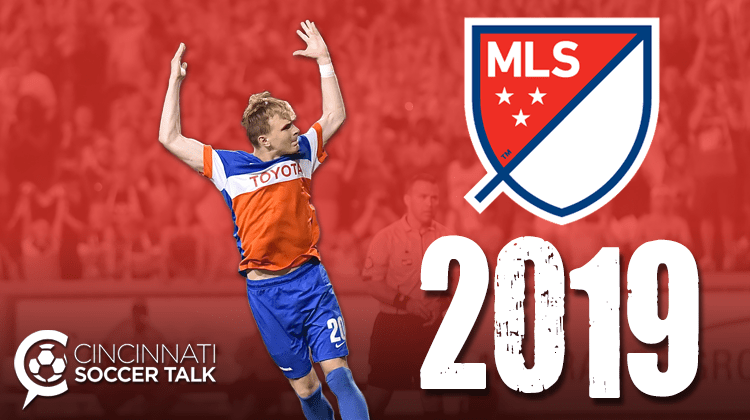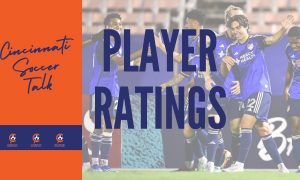MLS economics is a bit like the IRS tax code with different vocabulary. Replace deductions with allocations. Instead of adjusted gross income, each club has a budget. It can be complicated — but with knowledge of all the terms, it doesn’t have to be.
CST recently looked at important upcoming roster dates as FC Cincinnati transitions from USL to MLS. Here we’ll break down the economics behind the roster. All the information comes from mlssoccer.com.
Let’s start with the basics. Each club has 30 available roster spots. Spots 21-24 are for supplemental players, and spots 25-30 are for reserve players. Let’s push those aside for now and focus on the first 20, called senior spots. Each club is allowed eight international players, and those spots can be traded. International players are almost always senior spots but aren’t required to be.
There is a salary cap, but it should really be considered a salary budget. It’s even referred to as a budget on the MLS website. Each club has a salary budget of $4.035 million this season to fill those senior spots. The maximum amount allowed for a single player is $504,375. This amount can be exceeded under different designations. More on that shortly.
Roster spots 19 and 20 are not required to be filled, with MLS allowing clubs to spread their budget over fewer players to boost the amount paid to each player. If a club dips below 18 senior spots, it’s penalized a minimum salary budget charge for each player under spot 18.
Designated Players
Owners can pay designated players whatever they want — no maximum — but the contract must be approved by MLS. This is commonly known as the “David Beckham Rule” after the former European star signed with the Los Angeles Galaxy in 2007 and allows clubs to go after higher-profile talent.
The first part of a DP salary comes from the maximum allowed for a single player under the budget rules. Every dollar after that comes from ownership’s wallet. There are different maximum thresholds depending on the player’s age, called the maximum salary budget charge:
- For players 24 and older, that maximum is the $504,375 mentioned above, unless the player joins after the opening of the secondary transfer window (this year, July 10-Aug. 8). Then it’s $252,188
- For players 21-23, the maximum is $200,000
- For players 20 and younger, the maximum is $150,000
- For all players 23 and younger acquired after the opening of the secondary transfer window, the maximum is $150,000.
Each club is allowed two DPs with the option of obtaining a third by paying MLS $150,000. The fee is waived if it’s a young DP (23 and younger). This money does not go toward the player’s salary and will be redistributed to all clubs who did not buy an extra DP in the form of general allocation money the following MLS season. Consider the purchase of this third DP a luxury tax that’s spread to everyone else — with parity in mind.
General Allocation Money
In addition to the salary budget, each club receives general allocation money — $200,000 for this season. This money is on top of the salary budget and can be used to pay the difference between the budget and what a club wants to pay any player, DP or non-DP. There is a salary budget charge minimum of $150,000 for DPs, and a club cannot use GAM to reduce more than 50 percent of a player’s salary budget charge.
Clubs can receive extra GAM under the following conditions:
- They miss the playoffs
- They transfer a player outside of MLS
- They qualify for the CONCACAF Champions League by winning the U.S. Open Cup, Canadian Championship or MLS Cup in either of the previous two seasons
- In expansion years, all clubs receive an equal amount of additional GAM
- Any club losing a player in an expansion draft
- DP charge distribution mentioned above
Besides paying down a player’s contract, GAM can be used to sign players who did not play in MLS the previous season, re-sign existing players, offset loan and transfer fees, or to help with contract extension for the second year, provided the player was new to MLS the prior year.
GAM is also tradable.
Targeted Allocation Money
There’s also a distribution of targeted allocation money — $1.2 million for 2018 and 2019. Because FCC is an expansion club, its TAM amount for 2019 will be prorated. MLS clubs can spend an additional $2.8 million in TAM, funded by the club, for the next two seasons.
TAM is more specific than GAM, hence “targeted” as opposed to “general.” A player must earn more than the maximum salary budget charge to qualify for TAM. The ceiling for a player is $1.5 million. A player cannot have his salary budget charge bought down below $150,000. TAM and GAM cannot be combined to buy down a player.
TAM can be used in four ways:
- Buy down a DP to a non-DP in the same way as GAM. But that DP must simultaneously be replaced with a new DP at an investment equal to or greater than the player bought down
- Sign a new player, provided salary and acquisition costs are more than the maximum salary budget charge
- Re-sign an existing player if he’s earning more than the maximum salary budget charge
- Use $200,000 of TAM to sign a new homegrown player to his first MLS contract, subject to MLS review and approval
Like GAM, TAM is tradable, and GAM can be traded for TAM.
Supplemental and Reserve players
The salary budget doesn’t go toward the last 10 roster spots. Spots 21-24 are supplemental, and spots 25-30 are reserve.
All supplemental players must be paid at least the senior minimum salary of $67,500. They can be homegrown players, generation adidas players or a specific DP eligible for the super draft.
A homegrown player is someone who has been with a club’s academy for at least a year and has met necessary training and retention rights. Homegrown players can be signed without going through the MLS SuperDraft, and their contracts do not count against the salary budget. There’s no club limit on homegrown players.
Generation Adidas players are top domestic college players and youth national team players selected and signed by MLS and placed in the SuperDraft.
All reserve players in spots 25-28 must be 24 or younger and be paid at least the reserve minimum salary of $54,500. They can be homegrown players but not senior minimum salary players or generation Adidas players. Reserve spots 29 and 30 have the same restrictions but are for homegrown players only.
Acquisition mechanisms
There are certain U.S. Men’s National Team players, Youth National Team players or former MLS players that MLS wants in the league. They’re determined by MLS and placed on the allocation ranking list. There’s no order to the list, and it’s updated every year during the playoffs. It also can be updated when a player is transferred out of MLS for more than $500,000 and during the regular season if a preferred YNT player becomes list-eligible. The current list has 22 players and was last updated in December.
Should a player on the list become available and he wants to come to MLS, the allocation ranking order is used to determine which club can sign him. This order is set by reversing club standings, including playoff performance, at the end of each season. As an expansion club, FCC will be sent to the top of this list in 2019. Once a club uses its ranking to sign a player, that club falls to the bottom of the list. Rankings can be traded if part of the compensation returned is the other club’s ranking. Each club has only one spot in the order.
The discovery process allows clubs to scout and sign players not under MLS contract and not subject to other categories such as the allocation process or SuperDraft. The player must be on the club’s discovery list before he can be signed. This is how Atlanta United signed former FCC goalkeeper Mitch Hildebrandt. A club can have seven unsigned players on its list and can add or remove players at any time.
If multiple clubs have the same player on their discovery list, the club filing first has the rights to sign the player. If multiple filings were made on the same day, the club with the fewest points per match in the current MLS regular season gets the priority.
If a club wants a player on another discovery list, it can offer $50,000 for the right to sign him. The club with the desired player has five days (three during the secondary transfer window) to accept the offer or make the player its own reasonable offer.
@rspeirce for @CincySoccerTalk














